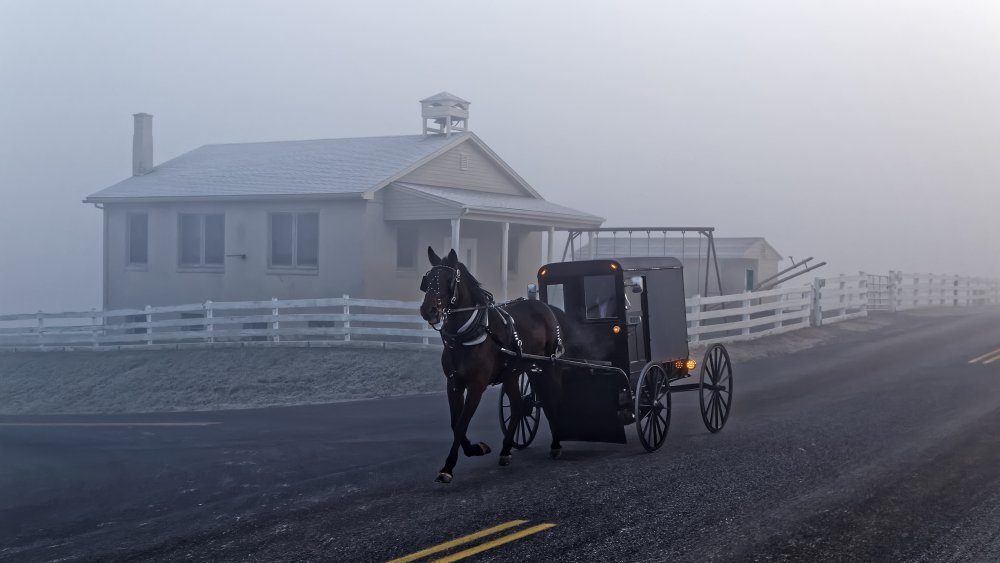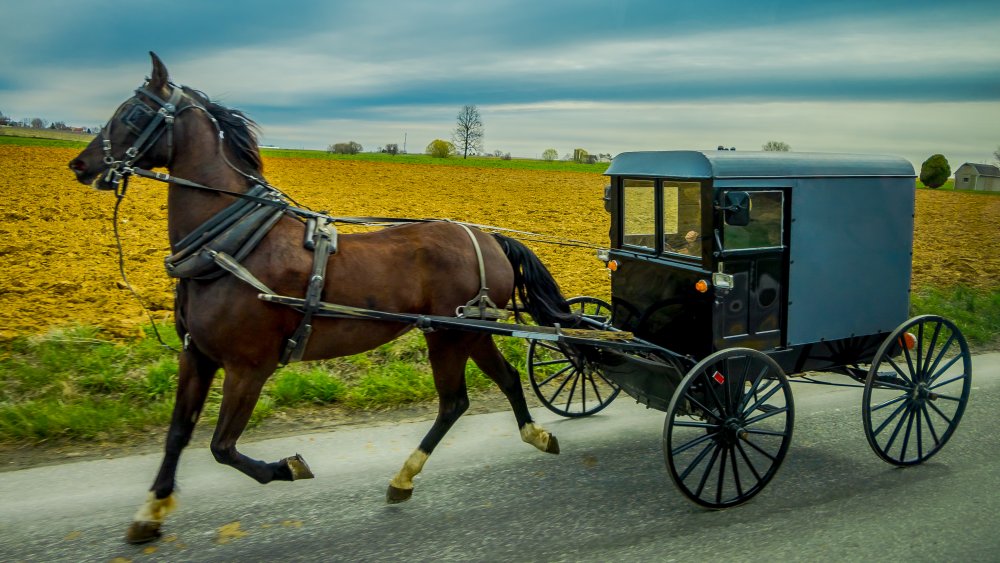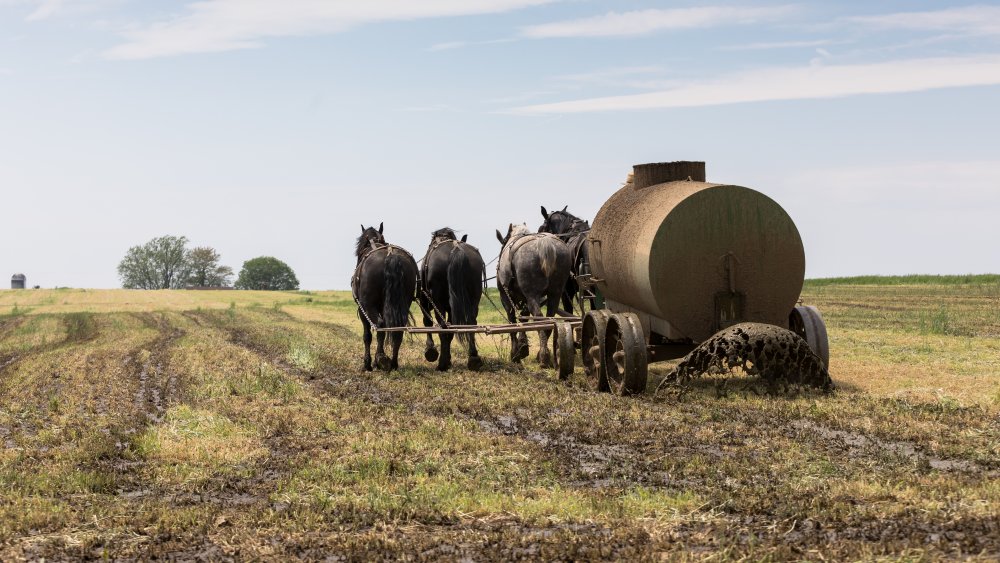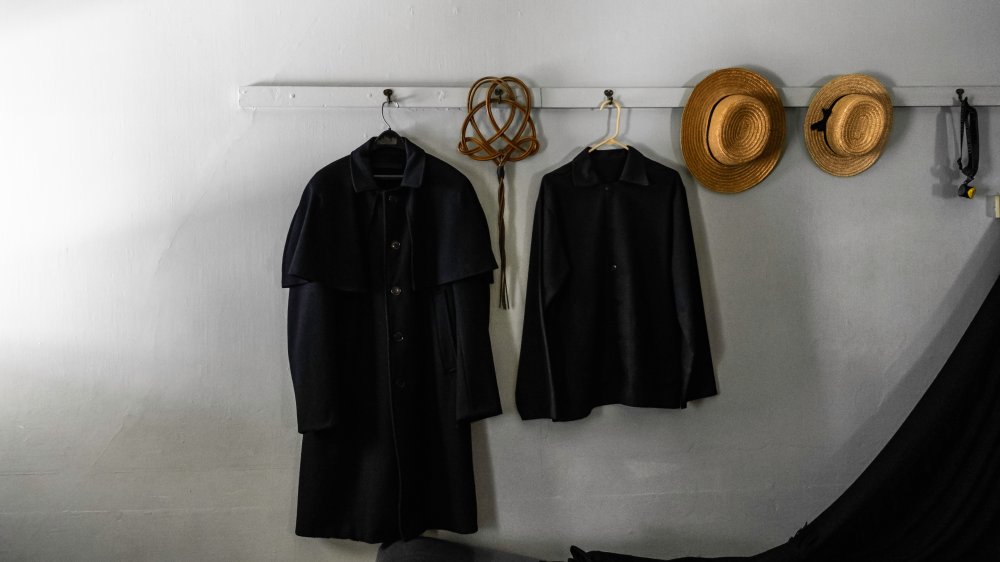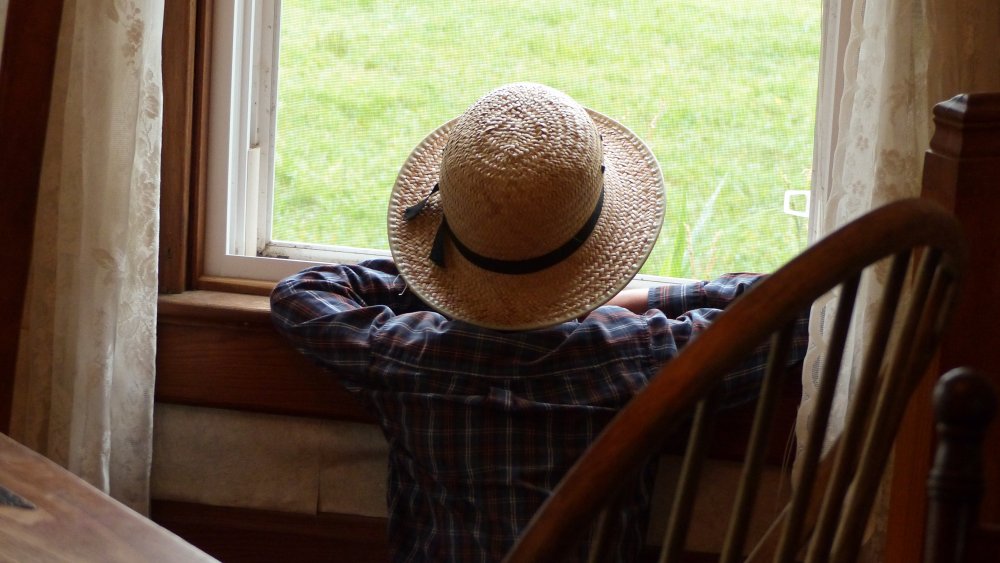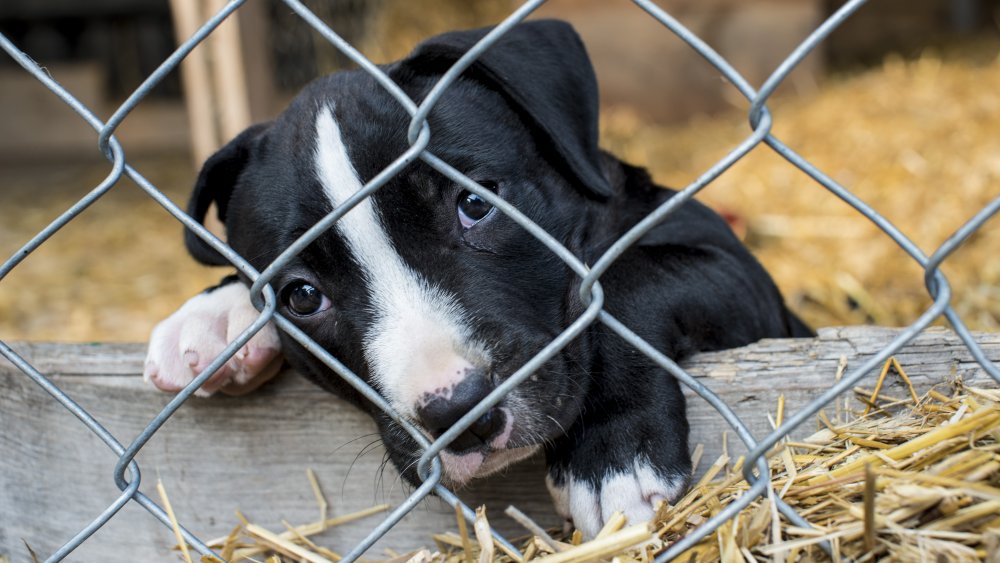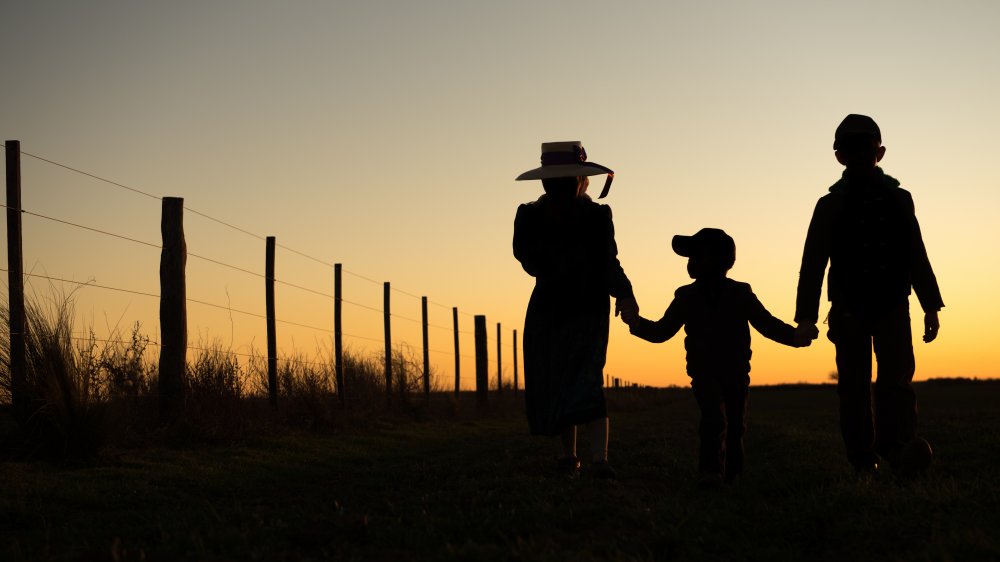The Dark Truth About Amish Country
The Amish have a bit of a reputation in the US: They're a group of people who live devoutly religious lives, and who refuse to allow modern conveniences like electricity and cars into their homes. They live their lives based on ideals like family, community, and a separation from the wider world. So separate, in fact, that you might wonder if the Amish have to pay taxes. But, they're basically good people ... right?
Do some digging — or listen to people who have left the Amish community — and you'll find it's more of a gray area.
The Amish have been around for a long time: Britannica says they first split from the Mennonites of Switzerland and southern Germany in the 1700s, when leader Jakob Ammann introduced some ideas that were pretty controversial for the time. He started preaching things like uniform dress, the social shunning of those who violated church rules, and the ex-communication of liars, and while he claimed he was just following Jesus' example, it proved too much for other Mennonites. So, they headed to the US in the 18th century and — in theory — lived the life they wanted to live.
But like in Amish country may not be as innocent and holy as you might think.
DUIs happen a lot in Amish country
The idea of someone being arrested for a DUI while driving a buggy might seem hilarious, but it's no laughing matter. It can be deadly. According to The Seattle Times, buggies are a massive traffic hazard. Between 2011 and 2015, the National Highway Traffic Safety Administration recorded 84 deaths occurring in 71 separate crashes, and they add there's likely more that weren't reported.
When crashes do occur, it's grim. Oswegatchie, New York town supervisor Alfred Nichols described it like this: "You hit one of these buggies and they're like kindling wood — they just kind of explode — and you almost always have to put the horse down. They get hit from behind, and the person in the buggy flies through the air because they don't wear seat belts." Most Amish and Mennonite families have lost someone in a traffic accident.
Yet it happens — a lot. In 2019, Reuben Yoder was arrested on 10 felony counts after side-swiping another vehicle and crashing his buggy — while he was drinking, and while a group of children between 9 months and 12 years old were with him (via the Independent). In 2020, an 18-year-old had been drinking when he ran a stop sign with his horse-and-buggy in New York, flipping the buggy, and injuring the horse (via WPDH). Driving while drinking — no matter what the vehicle — is always a serious offense.
The not-so-quaint horse and buggy
That's not the only issue on the roads of Amish country. A quick search of Amish news stories reveals a disturbing history: the mistreatment of animals. Specifically, the mishandling of the horses they're well-known for using for transportation.
In 2016, The Washington Post reported that police had charged a Pennsylvania Amish man with two counts of cruelty to animals. They were called to the scene by passers-by who saw — and recorded — the instance of a single horse being overburdened with a wagon of watermelons. Unable to pull it, the horse collapsed and then was hit by its owner. That's not the only instance of outside law enforcement getting involved: in 2011, officers were called to a Pennsylvania Costco parking lot, where two Amish had left horses tied. Both were swaying, suffering from heat exhaustion after standing in the sun on the 99-degree day (via NBC).
Then, there's the fate of most of the horses the Amish have used: the slaughterhouse. The site 83 degrees says that while many Amish will pay good money for horses deemed "ready for miles," those same horses are worked so hard they usually outlive their usefulness by the time they're in their teens. (Think of that as the equivalent of middle age in humans). They're taken to auction, traded for a newer, younger model, then often bought by kill buyers for a few hundred dollars. Horse rescues — like Saddlebred Rescue, Inc. — have been established to try to change that way of thinking, and save horses destined to be sold per pound to slaughterhouses.
Amish country is a major source of water pollution
In 2009, the Environment Protection Agency took a long, hard look at Amish farms in Lancaster County, Pennsylvania. They found (via Grist) that 85 percent of Amish farms had major health violations, including improper fencing (that would normally keep cows from adding their poop to local waterways), and high concentrations of E. coli in water sources.
And this wasn't just a problem contained to their farms — the whole investigation was kick-started by reports of pollution flooding into the Chesapeake Bay from three main areas, causing major algae blooms and ultimately, dead zones in the waterways, where there was so little oxygen in the water that it could no longer support life.
The Amish were one of three pollution "hot spots" identified by the EPA, and here's the thing: even though the agency was going to start holding farmers accountable for following the laws when it came to things like controlling sediment and keeping livestock out of the water, not everyone will comply. While some have decided to accept the laws — and the state funding set aside for improvements — others believe keeping to themselves and the old ways is more important. And they have a long way to go: they are, after all, still using old-school farming methods that destroy the soil, promote erosion, and ultimately pollute the areas around them — and, those downstream.
Terror in Amish country
In 2020, Cosmopolitan ran a piece on the findings of their year-long investigation into the Amish community, during which they found women who were willing to speak out about the horrible treatment they suffered behind the closed doors of their community.
Cosmopolitan reported that many girls in the Amish community were repeatedly attacked by members of the community. Sometimes, victims felt they couldn't speak up about these experiences because nobody else would vouch for their experience.
When her time among the Amish ended, reporter Sarah McClure of Type Investigations had found almost three dozen women who were willing to talk about the assaults they dubbed "an open secret spanning generations." In just the past two decades, she confirmed 52 cases in Amish communities across seven different states, and she went on to blame what she called "a perfect storm of factors." For starters, there's the fact the Amish are living in isolated, patriarchal communities that limit their social awareness, and they're folded into a community that preaches forgiveness and obedience.
The clergy and religious beliefs are used to keep people quiet
When Cosmopolitan did their investigation into reports of abuse among Amish communities, they found there was a very simple reason that it had remained a secret for so long: "We're told that it's not Christlike to report. It's so ingrained. There are so many people who go to church and just endure," a woman who went by Esther told the magazine.
Investigator Sarah McClure said that was the case with almost every Amish victim she interviewed. Family and church leaders alike warned them not to say anything about their experiences, as they would face ridicule, victim-shaming, and even ex-communication from the church.
Linda Crockett, the founder and director of Safe Communities, says that's been very slowly changing. More Amish women are coming forward, even if it means leaving the church and communities they grew up in. Crockett says, "They hear about each other — not on Twitter or Facebook, but there's a strong communication system within these communities. They draw courage and strength from each other."
Consequences can be relatively mild in Amish country
Cosmopolitan and investigator Sarah McClure found that when it comes to crimes among the Amish, victims were in part discouraged because the punishment rarely fits the crime.
The punishment for one disgraced father? Six weeks of shunning (social ostracization and eating meals separately from the rest of the community), a church confession, and a community who encouraged forgiveness. Not long after, things were back "to how it had been before." Outside law enforcement did try to intervene, but according to their notes, things had been "dealt with in the church." The community urged the victim not to speak about the topic again, but authorities did return.
It actually didn't get much better. The man ended up in court, but Pennsylvania district attorney Craig Stedman says there's almost always a problem: "We've had cases where there'll be 50 Amish people standing up for the offender and no one speaks for the victim."
With overwhelming community support, the man only got probation. He returned home to his family and continued his criminal behavior, undeterred by the outcome.
The Amish send people to clinics, but not for mental health
When investigator Sarah McClure started looking into why so many in the Amish community keep quiet about allegations, she uncovered something else horrifying: sometimes, it meant victims were sent away.
McClure spoke with Lizzie (not her real name), who said (via Cosmopolitan) that when she spoke out, she was bullied for what the community claimed was a "consensual affair." She recalled, "They didn't ask me how I felt or my side of the story." Instead, she was labeled as having "mental issues." Lizzie was then sent to a so-called "chiropractic clinic," where she was told to "work through [her] emotional stuff."
McClure found that her account of a mysterious facility — always staffed by other Amish or Mennonites — wasn't the only one. Others told similar stories, and some say they were forced to take a cocktail of drugs that left them "zombies." Lizzie said she knew of 30 other women who had been similarly treated, and when Esther went, she was forced to take "sleep medication." It wasn't for sleep: it was olanzapine, which is used to treat schizophrenia. Esther started having hallucinations but stayed on the drug for weeks as she knew it was the only way to get out. Esther and Lizzie have both since left the church.
Are the Amish invested in puppy mills?
Sometimes, it's claimed that the Amish own about 20 percent of America's puppy mills. Snopes says that's not entirely true, but just for one reason: it's impossible to tell just how many they own and run. (And, it's also important to note that puppy mills are constantly closing and/or moving.)
The Humane Society of the United States estimates there are around 10,000 puppy mills in the country, and yes, many have been linked to the Amish community. In 2017, for example, the SPCA seized 27 dogs from a Lancaster County breeder, treated those that were in desperate need of medical attention, and rehomed them — then, they pressed charges against the breeder, per Snopes.
Live Wire Lancaster reported that in 2009, Lancaster County had been declared the "Puppy Mill capital of the US," a title they directly linked to their large Amish population. They estimated there were around 600 unlicensed breeding facilities operated out of Lancaster County sheds and barns, and wrote, "Not only do the Amish operate these puppy-mills, they ensure the public does not hear rumblings inside by stressing the importance of maintaining secrecy."
Stopping them has proven difficult, says Bill Smith of Main Line Animal Rescue. "People are deceived. [...] they walk away with a dog and don't realize that there are 500 dogs in a barn and are suffering horribly."
The Amish suffer from a high instance of genetic disorders
In 2005, 60 Minutes took a close look at a widespread problem in Amish communities: genetic diseases. And it wasn't just genetic disease, they were suffering from diseases so rare they didn't even have names. In other instances, the Amish community contained almost a third of all global cases.
They traced it back to the "founder effect." The majority of Amish trace their lineage back to the same group of German-Swiss immigrants who settled in the US in the 1700s, and there were only a few hundred members of that group. Today, prolonged intermarriages are causing such a widespread problem that some communities have opted to build clinics just to care for their special needs children.
In 2020, Health Europa reported the results of a shocking study done by the University of Exeter. They found 150 genetic disorders in Amish communities, and estimated as much as 80 percent of all Amish have a genetic disorder. Even more surprising were the 25 disorders that were discovered there — they're known nowhere else in the world.
Diseases are serious, too: They're things like the Maple syrup urine disease, which causes the body to turn protein into a poison that causes brain damage, and Cohen syndrome, which causes a range of symptoms including weak muscle tone that keeps some sufferers from even being able to support the weight of their own body (via Medline Plus).
The Amish are facing some serious drug problems
In 2018, People reported on something that seemed incredibly weird: Sabrina Burkholder from Breaking Amish had almost died after a heroin overdose. The incident was a relapse: she had been clean for a year when her friend gave her "a capful of [heroin]" for her birthday, and it was the last thing she remembered.
She survived after a dose of Narcan, and she's not alone in her problems. In 2016, ABC News had reported that opioid addiction — including heroin — was becoming an increasing problem in the Amish communities of Indiana, even quoting a community elder as saying, "It's just slowly creeping in here."
And it had been for a long time. In 1998, the Associated Press was reporting on something even more surprising: Two Amish men had been arrested for their part in a cocaine ring. They had been buying from the members of a motorcycle gang and selling to their Lancaster County, Pennsylvania community. While that might have sounded surprising to most, Lancaster County natives say it was sort of a well-known secret. One, a local businessman named Jack Meyer, told Kitsap Sun, "People here have known that there has been a lot of drug problems with Amish youth, and with liquor, too."
When the Amish go missing
The Amish have also been the targets of some terrible kidnappings. In 2014, two of the Miller family's 13 children were attending to their fruit stand in Oswegatchie, New York, while their family tended the animals. That, says The Washington Post, is when a white sedan pulled up then drove away with the 7- and 12-year-old girls. Police were called, and since the Amish don't allow photographs to be taken, the best they could do was a verbal description. (They allowed a sketch of one girl to be released, but forbid a sketch of the other.)
The girls were suddenly dropped off on the doorstep of a home and later pointed police to Stephen Howells II and Nicole Vaisey. Details were scarce, but law enforcement did say that the girls had been "victims of crimes" while they were held. CNN later reported that their kidnappers were handed 25-year sentences for kidnapping charges, and that would be served concurrently with other sentences: 580 years for Howells and 300 years for Vaisey.
And here's the thing: they weren't targeting the Amish, but they were just looking for "opportunities" — and they saw it in the little girls left to tend a family business alone.
Other kidnappings have happened as well: In July 2020, NBC reported on the arrest of a man for the kidnapping of 18-year-old Linda Stoltzfoos. She disappeared in June when walking home from church, and she was still missing.
The Bergholz barbers and violence against the Amish
The Amish community's devout faith is one of the things that defines them, but it's also made prosecuting crimes against them — and committed by them — difficult. Just take the very confusing case of the Bergholz barbers.
In 2011, 16 people carried out a series of five attacks targeting Amish men and women in Ohio. They would break into homes, restrain the victims, and shave their hair or beards — a massive offense in the Amish culture. They were ultimately found to be former members of another Amish community in the area, and here's where things get tricky.
This other community in Bergholz was founded by Sam Mullet, who claimed he'd started his group because the mainstream Amish weren't strict enough. Although they still called themselves Amish, as per The Atlantic, the off-shoot group also got rid of church attendance, used paddles as a way of settling arguments, and adult women moved in with the married Mullet.
According to The Atlantic, conflict between Mullet and other Amish groups led to the attacks, but ... does that all make it a hate crime? Originally, the courts ruled yes, but that was overturned thanks to some sticky language.
Confusing? Absolutely, but Elizabethtown College sociologist Donald Kraybill summed up the moral of the story like this: "They're just like us. They've got some problems, too. They're not goody-goody saints like they'd like us to think they are — they can become angry and violent, as well."

